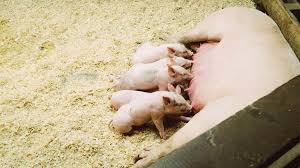Milk ejection and lactation are consequence of parturition. Milk ejection can be induced by low dose prostaglandin. Injection of low dose prostaglandin F2 alpha (PGf22) (non-luteolytic dose) in animals two weeks after breeding results in milk ejection.
The intrajugular administration of a subluteolytic dose of PGF2α induces a large increase in intramammary pressure when given during the luteal phase and this is directly correlated to the plasma progesterone (P4) profiles.
Removal of the prolactin inhibiting factors also results in milk ejection and lactation.
Weaning Methods
Weaning refers to the process of causing the young to become accustomed gradually to food other than its mother’s milk.
It is important to decide when and by what means to wean calves, because it influences the weaning mass of calves as well as the condition of the cows and indirectly their conception rates.
Timing
The major priority in beef cattle production is to produce as many calves as possible. The main objective of weaning is therefore to enable a cow to calve every year by allowing her to regain condition after weaning.
Calves are ideally weaned when they are 7 to 8 months old.
The right time to wean a calf depends on the condition of the cow and not the age of the calf.
Calves should be weaned before the condition score of the cow falls below 2-5 if adequate feed is available and the cows maintain their condition. The calves should preferably be weaned before the cow’s condition score falls below 3.0.
During years of draught and poor feed supply, calves should be weaned early (about 6 months), to allow the cow to recover before the onset of winter or harmattan.
It is important that the cow should recover and that secretory tissue be restored before the next calf is born.
Early Weaning
This practice should only be considered during times of severe drought or feed shortages.
Calves weaned at a relatively young age (less than 5 months) experience severe setbacks.
If the condition of the cow deteriorates considerably before the planned weaning time, the producer must decide whether to:
Wean early and supply concentrate feeding to the calf.
Provide a roughage supplement to the cows that are still suckling their calves.
This decision will depend on the availability and cost of feed. Generally, the feed (mainly concentrates) costs to rear early – weaned calves are relatively high. Therefore, feeding concentrates to calves should only be considered during adverse conditions.
Methods of Weaning

Circumstances on the farm determine the method of weaning. The following methods can be used:
Keep the calves in a kraal or well-fenced camp and remove the cows to a distant camp, preferably out of earshot of the calves.
Remove the cows temporarily from a camp and in their absence move the calves to another distant camp. Cows tend to look for their calves in the camp in which they were last seen and this method should prevent the cows from breaking out of the camp.
Exchange calves from two different herds. The calves will then have the company of cows. Some cross-suckling is however, likely to occur.
Read Also : Guide to Proper Artificial Insemination in Farm Animals
Separate the cows and calves by a strong, close-strand wire fence. This method can reduce weaning stress
Nose plates, commercially available or home-made can be fitted to calves for 7 to 14 days. These prevent suckling, even if cows and calves remain together throughout the weaning period. When the nose plates are removed the cows and calves are separated, but with relatively little stress.
General
Perform castration, dehorning and branding when calves are 2 to 3 months old, not immediately before weaning. This will ensure that the stress associated with these operations does not add to that of weaning.
A few dry cows can be kept with the weanere to calm them.
Provide sufficient good-quality roughage, water and shade in the weaning camps. To prevent excessive walking and trampling the camps should not be too large.
The weaning process could last 7 to 14 days, depending on the age at which the calves are weaned as well as the breed of the cow.
In summary, milk ejection and lactation are ordinary consequences of parturition. However, milk ejection can be induced by low dose pasta landing; removal of the prolactin inhabiting factors also results in milk ejection and lactation.
Weaning refers to the process of causing the young to become accustomed gradually to food other than its mother’s milk. Circumstances on the farm determine the method of weaning.
Read Also : Household Hazardous Waste Complete Management Guide
